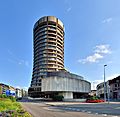Monetary policy facts for kids
Monetary policy is the policy used by the monetary authority of a country that controls either the interest rate that can be paid on very short-term borrowing or the money supply. They often target inflation or the interest rate to help make price stability and general trust in the currency.
Other goals of a monetary policy are usually to help make the gross domestic product more stable, to get and keep low unemployment, and to have predictable exchange rates with other currencies.
Images for kids
-
Clockwise from top-left: Federal Reserve, Bank of England, European Central Bank, Bank of Canada
-
Banknotes with a face value of 5000 in different currencies. (United States dollar, Central African CFA franc, Japanese yen, Italian lira, and French franc)
-
Reproduction of a Song dynasty note, possibly a Jiaozi, redeemable for 770 mò.
-
Gold certificates were used as paper currency in the United States from 1882 to 1933. These certificates were freely convertible into gold coins.
-
The Bank of Japan, in Tokyo, established in 1882.
-
The Bank of Finland, in Helsinki, established in 1812.
-
The headquarters of the Bank for International Settlements, in Basel (Switzerland).
-
The Reserve Bank of India (established in 1935) Headquarters in Mumbai.
-
The Central Bank of Brazil (established in 1964) in Brasília.
-
The Bank of Spain (established in 1782) in Madrid.
See also
 In Spanish: Política monetaria para niños
In Spanish: Política monetaria para niños













